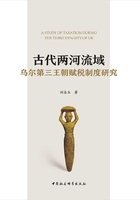
五 基本思路
乌尔第三王朝的赋税制度与乌尔国家的政治、经济和社会生活等方面密切相关,所以要研究赋税制度,我们首先要对乌尔第三王朝的具体情况有一个总体上的了解和认识。因此,本书专门用一章来宏观介绍乌尔第三王朝的概况,作为探讨各项赋税制度的历史背景。乌尔第三王朝的历史虽然只有短短百余年时间,但是却留下了数以十万计的楔形文字泥板文献资料,成为我们还原这段历史的最直接证据,也是研究其赋税制度的第一手资料来源。本书注重实证研究,坚持论从史出,在分析前人关于古代两河流域赋税制度研究成果的基础上,通过梳理乌尔第三王朝的核心行省税、外围行省税、附属国税、王室税、神庙税,研究税制改革与乌尔第三王朝国家治理之间的关系,从赋税制度对乌尔第三王朝政治和经济等诸方面的作用来认识乌尔第三王朝的兴衰演进,进而总结早期文明国家的历史发展规律。
第一章介绍乌尔第三王朝的概况。首先介绍乌尔第三王朝的地理概况,包括地理条件与位置、自然环境特征以及行政区划,接着介绍乌尔第三王朝的历史概况,分析乌尔第三王朝由建立到扩张、由盛而衰的历史发展过程,进而分析乌尔第三王朝的灭亡原因。最后,介绍乌尔第三王朝的各种文本文献,包括经济管理文献、王室铭文、书信、信使外交文献、文学文献、法律文献等,分析普兹瑞什达干、温马、吉尔苏、尼普尔、乌尔、伊利萨格里格的经济管理文献特征及其对研究乌尔第三王朝赋税制度的重要性。
第二章探讨核心行省的bala税。首先介绍了乌尔第三王朝行省制度的发展演变和组织结构等基本情况,具体介绍核心行省(核心区)的构成以及每个行省的具体情况。然后,重点分析核心行省的bala税,包括其术语和词源含义、赋税形式、赋税来源(纳税人)、赋税运送、赋税目的地(收税人)及其用途、税率、税务官员等基本情况。最后具体探讨温马行省和拉伽什—吉尔苏行省的bala税具体情况。
第三章分析外围行省的gun2 ma-da税。概述乌尔第三王朝的外围行省(或称外围区、军事缓冲区)概况及组成,乌尔中央对外围行省的管理和控制以及外围区对乌尔第三王朝的意义和作用等基本情况。介绍了gun2 ma-da税的赋税形式、赋税来源(纳税人)、赋税运送、赋税目的地(收税人)及其用途、税率、税务官员等内容。
第四章研究附属国的gun2税。通过区分gun2税和gun2 ma-da税的术语含义,介绍了gun2税的赋税形式、赋税来源(纳税人)、赋税运送、赋税目的地(收税人)及其用途、税率、税务官员等内容。
第五章研究王室maš2-da-ri-a税。首先考证maš2-da-ri-a术语的词源及使用范畴,接着介绍maš2-da-ri-a税的征收方式、课税形式、赋税用途等基本情况,进而分析maš2-da-ri-a税同乌尔王室之间的关系。
第六章讨论神庙zag-u税。首先介绍乌尔第三王朝的神庙体系以及发展演变,分析神庙经济和神庙势力在古代两河流域历史上的地位和作用,然后分析什一税的起源与发展演变、征收的物品、征收的渠道和方式、征收什一税的目的等内容。
第七章探讨赋税制度与乌尔第三王朝国家治理之间的密切关系,通过舒尔吉、阿马尔辛和舒辛三位国王统治时期进行的税制措施,分析乌尔第三王朝政治、经济与文明的发展与兴衰。
在结论部分,我们归纳和总结了乌尔第三王朝赋税制度的特点和历史意义,以及赋税制度与乌尔第三王朝的政治、经济与文化发展之间的关系。
[1] 何盛明主编:《财经大辞典》下卷,中国财政经济出版社1990年版,第2022页。
[2] 《马克思恩格斯选集》第3卷,人民出版社2009年版,第376页。
[3] [英]亚当·斯密:《国民财富性质和原因的研究》下册,郭大力、王亚南译,商务印书馆1974年版,第383页。
[4] [日]小川乡太郎:《租税总论》,萨孟武译,商务印书馆1935年版,第11页。
[5] 《列宁全集》第32卷,人民出版社1958年版,第275页。
[6] 《马克思恩格斯选集》第1卷,人民出版社2012年版,第766页。
[7] 《马克思恩格斯全集》第1卷,人民出版社1972年版,第181页。
[8] 又名美索不达米亚文明。两河流域(Mesopotamia),音译为“美索不达米亚”,源自古希腊语Μεσοποταμíα,意为“河流之间的土地”。这里的“两河”指幼发拉底河和底格里斯河。关于古代两河流域历史的时段划分,主要参考:A.L.Oppenheim,Ancient Mesopotamia,Chicago-London:University of Chicago Press,1964;M.Van de Mieroop,A History of the Ancient Near East,ca.3000-323 BC,Malden-Oxford-Carlton:Blackwell Publishing,2007;刘文鹏主编《古代西亚北非文明》,中国社会科学出版社1999年版;于殿利《巴比伦与亚述文明》,北京师范大学出版社2013年版。
[9] 关于古代两河流域文明发展过程中的三种国家形态,参见M.Van de Mieroop,A History of the Ancient Near East,ca.3000-323 BC,Malden-Oxford-Carlton:Blackwell Publishing,2007.
[10] 关于古代两河流域的考古发掘历史,参见拱玉书《西亚考古史(1842—1939)》,文物出版社2002年版。
[11] 本书中的苏美尔语单词和语义符一律用正体,阿卡德语单词一律用斜体。由于乌尔第三王朝的赋税名称很难准确译成汉语,加之其含义在不同学者中存在争议,本书不按中国学术界的惯例译成汉语,而是按国际亚述学惯例只给其拉丁化形式。
[12] D.R.Frayne,Presargonic Period (2700-2350 BC),The Royal Inscriptions of Mesopotamia Early Periods,Volume 1,Toronto-Buffalo-London:University of Toronto Press,1998,pp.193-236.
[13] D.Frayne,Sargonic and Gutian Periods (2334-2113 BC),The Royal Inscriptions of Mesopotamia Early Periods,Volume 2,Toronto-Buffalo-London:University of Toronto Press,1993,pp.7-39.
[14] D.O.Edzard,Gudea and His Dynasty,The Royal Inscriptions of Mesopotamia Early Periods,Volume 3/1 (RIME 3/1),Toronto-Buffalo-London:University of Toronto Press,1997,pp.68-100.
[15] D.R.Frayne,Presargonic Period (2700-2350 BC),The Royal Inscriptions of Mesopotamia Early Periods,Volume 1,Toronto-Buffalo-London:University of Toronto Press,1998,pp.259-265.
[16] 在古代两河流域年代学研究中,共存在三种不同的年代学:“高年代学”(High Chronology)、“中年代学”(Middle Chronology)和“低年代学”(Low Chronology)。本书采用的是传统上被普遍接受的“中年代学”,即认为乌尔第三王朝的时间范围是公元前2112—前2004年,参见A.L.Oppenheim,Ancient Mesopotamia:Portrait of a Dead Civilization,Chicago:University of Chicago Press,1964。除此之外,还有学者认为“高年代学”可能更加准确,参见P.J.Huber,“Astronomical Dating of Babylon I and Ur III”,Monographic Journals of the Near East,Vol.1/4 (1982),pp.1-19;P.J.Huber,“Astronomical Evidence for the Long and against the Middle and Short Chronologies”,in P.Åström (ed.),High,Middle or Low?Acts of an International Colloquium on Absolute Chronology held at the University of Gothenburg 20th-22nd August 1987,Göteborg:Paul Äströms Förlag,1987/89,pp.5-17.
[17] 《马克思恩格斯选集》第4卷,人民出版社1972年版,第167页。
[18] 参见国洪更《亚述赋役制度考略》,中国社会科学出版社2015年版。
[19] S.Langdon,Tablets from the Archives of Drehem,Paris:Librairie Paul Geuthner,1911.
[20] 比如:C.Liu,“An Ur III Tablet from Southwestern University”,Aula Orientalis,Vol.32,No.1 (2014),pp.175-176.
[21] M.Sigrist,T.Ozaki,Neo-Sumerian Administrative Tablets from the Yale Babylonian Collection,Part 1-2,Madrid:Consejo Superior de Investigaciones Científicas,2009.
[22] M.Sigrist,T.Gomi,The Comprehensive Catalogue of Published Ur III Tablets,Bethesda:CDL Press,1991.
[23] A.Garcia-Ventura,“Ur III Studies:Bibliography 1997-2014”,Studia Orientalia,Vol.3 (2015),pp.22-47.
[24] https://cdli.ucla.edu/.
[25] http://bdtns.filol.csic.es/.
[26] I.Schrakamp,P.Paoletti,“Steuer”,Reallexikonder Assyriologie und Vorderasiatischen Archäologie,Vol.13 (2011-2013),pp.163-164.最新关于乌尔第三王朝赋税的概述,参见:S.Alivernini,“Management of Resources and Taxation in an Early Mesopotamian Empire:the Case of the Third Dynasty of Ur”,in Mynarova,J.,Alivernini,S.(eds.),Economic Complexity in the Ancient Near East,Management of Resources and Taxation(Third-Second Millennium BC),Prague:Charles University,2020,pp.69-86.
[27] W.W.Hallo,“A Sumerian Amphictyony”,Journal of Cuneiform Studies,Vol.14 (1960),pp.88-114.
[28] 关于古希腊术语“近邻同盟”,参见H.Chambers,“Ancient Amphictyonies,Sic et Non”,in W.W.Hallo (ed.),Scripture in Context III,Winona Lake:Eisenbrauns,1983,pp.39-59.
[29] P.Steinkeller,“The Administrative and Economic Organization of the Ur III State:The Core and the Periphery”,in M.Gibson,R.D.Biggs (eds.),The Organization of Power:Aspects of Bureaucracy in the Ancient Near East,Chicago:The Oriental Institute of the University of Chicago,1987,pp.15-34.
[30] P.Steinkeller,“The Administrative and Economic Organization of the Ur III State:The Core and the Periphery”,in M.Gibson,R.D.Biggs (eds.),The Organization of Power:Aspects of Bureaucracy in the Ancient Near East,Chicago:The Oriental Institute of the University of Chicago,1987,pp.28-29.
[31] T.Maeda,“Bal-ensí in the Drehem Texts”,Acta Sumerologica,Vol.16 (1994),pp.115-164;T.Maeda,“Šà-bal-a in Umma Tablets:Bal duty of the Ensí of Umma”,Acta Sumerologica,Vol.17 (1995),pp.145-174.
[32] T.Sharlach,Provincial Taxation and the Ur III State,Cuneiform Monographs 26,Leiden:Brill,2004.
[33] P.Michalowski,“Foreign Tribute to Sumer in Ur III Times”,Zeitschrift für Assyriologie und Vorderasiatische Archäologie,Vol.68 (1978),pp.34-49.
[34] D.I.Owen,“Tax Payments from Some City Elders in the Northeast”,Acta Sumerologica,Vol.3 (1981),pp.63-76.
[35] T.Maeda,“The Defense Zone during the Rule of the Ur III Dynasty”,Acta Sumerologica,Vol.14 (1992),pp.135-172.
[36] A.L.Oppenheim,Catalogue of the Cuneiform Tablets of the Wilberforce Eames Babylonian Collection in the New York Public Library:Tablets of the Time of the Third Dynasty of Ur,New Haven:American Oriental Society,1948,p.30.
[37] T.Maeda,“Bringing (mu-túm) Livestock and the Puzrish-Dagan Organization in the Ur III Dynasty”,Acta Sumerologica,Vol.11 (1989),pp.98-99.
[38] W.Sallaberger,Der kultische Kalender der Ur III-Zeit,Berlin and New York:Walter de Gruyter,1993,pp.160-170.
[39] M.Sigrist,Drehem,Bethesda:CDL Press,1992,pp.190-192.
[40] G.J.Selz,“Maš-da-ři-a und Verwandtes.Ein Versuch über da-ři ‘an der Seite führen’:ein zusammengesetztes Verbum und einige nominale Ableitungen”,Acta Sumerologica,Vol.17 (1995),pp.251-274.
[41] 关于乌尔第三王朝的宗教神庙祭祀与供品的研究,参见R.L.Zettler,The Ur III Temple of Inanna at Nippur:The Operation and Organization of Urban Religious Institutions in Mesopotamia in the Late Third Millennium B.C .,Berlin:Dietrich Reimer Verlag,1992;W.Sallaberger,Der kultische Kalender der Ur III-Zeit,Berlin and New York:Walter de Gruyter,1993;M.Such-Gutiérrez,Beiträge zum Pantheon von Nippur im 3.Jahrtausend,Rome:Herder Libreria editrice,2003.
[42] E.Salonen,Über den Zehnten im alten Mesopotamien:Ein Beitrag zur Geschichte der Besteuerung,Helsinki:Suomalaisen Kirjallisuuden Kirjapaino Oy,1972,亦可参见刘昌玉、应俊《欧洲什一税源于古代两河流域》,《中国社会科学报》2018年10月29日。
[43] D.C.Snell,“The Ur III Tablets in the Emory University Museum”,Acta Sumerologica,Vol.9 (1987),p.228;A.L.Oppenheim,Catalogue of the Cuneiform Tablets of the Wilberforce Eames Babylonian Collection in the New York Public Library:Tablets of the Time of the Third Dynasty of Ur,New Haven:American Oriental Society,1948,p.5.
[44] P.Steinkeller,“The Renting of Fields in Early Mesopotamia and the Development of the Concept of ‘Interest’ in Sumerian”,Journal of the Economic and Social History of the Orient,Vol.24 (1981),pp.113-145;K.Maekawa,“Agricultural Texts of Ur III Lagash of the British Museum (IV)”,Zinbun,Vol.21 (1986),pp.122-125;H.Neumann,“Grundpfandbestellung und Feldabgabe unter rechts-und sozialvergleichendem Aspekt (mit Bemerkungen zur Lesung und Interpretation von CST 60,11 und MVN III 336,11)”,in H.Klengel and J.Renger (eds.),Landwirtschaft im alten Orient:Ausgewählte Vorträge der XLI.Rencontre Assyriologique Internationale Berlin,4.-8.7.1994,Berliner Beiträge zum Vorderen Orient 18,Berlin:Dietrich Reimer Verlag,1999,pp.137-148.
[45] W.Sallaberger,Der kultische Kalender der Ur III-Zeit,Berlin and New York:Walter de Gruyter,1993.
[46] 国洪更:《亚述赋役制度考略》,中国社会科学出版社2015年版。
[47] 郭丹彤:《论古代埃及的赋税体系》,《东北师大学报》(哲学社会科学版)2016年第3期。
[48] 王三义:《古罗马“赋税名目”考略》,《史学月刊》2002年第6期;王三义:《罗马税制的积弊与戴克里先税制改革》,《世界历史》2007年第1期;徐国栋:《罗马人的税赋——从起源到戴克里先登基》,《现代法学》2010年第5期;崔国强:《罗马帝国税收钱币化探析》,《外国问题研究》2018年第3期。
[49] 顾銮斋:《英国中古前期的税收习惯》,《世界历史》2014年第6期;顾銮斋:《赋税制度与欧洲政治制度的演进》,《史学理论研究》2014年第2期;熊芳芳:《从“领地国家”到“税收国家”:中世纪晚期法国君主征收权的确立》,《世界历史》2015年第4期;顾銮斋:《赋税变迁与欧洲文明》,《光明日报》2018年8月13日。
[50] 据莫利纳在2008年时的统计,乌尔第三王朝经济文献共计87241件,其中已发表的有74225件,尚未发布的有13016件,参见M.Molina,“The Corpus of Neo-Sumerian Tablets:An Overview”,in S.J.Garfinkle and J.C.Johnson (eds.),The Growth of an Early State in Mesopotamia:Studies in Ur III Administration,Madrid:Consejo Superior de Investigaciones Científicas,2008,p.20.目前乌尔第三王朝的泥板文献的具体数目无从考证,随着新文献的不断被发现、释读,这个数目会持续保持增长态势。
[51] M.W.Green,“Early Sumerian Tax Collectors”,Journal of Cuneiform Studies,Vol.36 (1984),pp.93-95.
[52] 文献UET 3 1310 (IS 6,Ur).注意:根据国际亚述学惯例,文献的表示方式为“原始文献出处(文献日期,文献地点)”。本书引用的楔形文字原始文献出处的字母缩写,参见牛津大学“亚述学缩写”规范,网址为http://cdli.ox.ac.uk/wiki/abbreviations_for_assyriology,最近浏览日期:2021年1月1日。“原始文献出处”后面的“(文献日期,文献地点)”(IS 6,Ur)表示“伊比辛6年,地点为乌尔”。其中,S代表舒尔吉、AS代表阿马尔辛、SS代表舒辛、IS代表伊比辛、--代表统治者名字不详,undated代表统治者及统治年份均不详,后面的数字表示统治年份,罗马数字i—xii代表月份,d代表闰月,比如IS 6表示“伊比辛统治第6年”,SS 6 viii 5表示“舒辛统治第6年,第8月,第5日”,S 48 xid表示“舒尔吉统治第48年,闰11月”;关于“文献地点”,Drehem代表德莱海姆(普兹瑞什达干)、Girsu代表吉尔苏、Irisagrig代表伊利萨格里格、Nippur代表尼普尔、Umma代表温马、Ur代表乌尔。
[53] 文献BPOA 1 1086 (undated,Umma).
[54] 文献AfO 24 pl.17 Truro 1 (S 36,Girsu),RSO 83 343 5 (S 45 x,Drehem).
[55] 文献STA 11 (AS 1,Umma),YOS 4 3 (SS 6 viii 5,Umma).
[56] 文献BPOA 6 1053 (--xi,Umma),YOS 15 204 (undated,Umma).
[57] 文献SNAT 345 (AS 4,Umma),SNAT 347 (AS 4,Umma),TCL 5 6046 (AS 4,Umma).
[58] 文献UET 3 48 (undated,Ur).
[59] 文献BPOA 6 1004 (S 45,Umma),BPOA 1 1206 (AS 8 xii,Umma),AAICAB 1/3 pl.249 Bod S 306 (SS 2,Umma),TCBI 2/2 1 (SS 6-9,Umma),UTI 5 3186+3415 (SS,Umma),ZA 95 191 (SS 7-IS 1,Umma),Nisaba 23 65 (undated,Umma),SNAT 537 (undated,Umma).
[60] 文献UTI 4 2577 (S 46 xi,Umma),AUCT 3 479 (AS 6).
[61] 文献BPOA 2 2345 (S 36 vii,Umma).
[62] 刘家和、廖学盛主编:《世界古代文明史研究导论》,北京师范大学出版社2010年版,第19页。
[63] 王三义:《古罗马“赋税名目”考略》,《史学月刊》2002年第6期;王三义:《罗马税制的积弊与戴克里先税制改革》,《世界历史》2007年第1期;徐国栋:《罗马人的税赋——从起源到戴克里先登基》,《现代法学》2010年第5期。
[64] 顾銮斋:《赋税制度与欧洲政治制度的演进》,《史学理论研究》2014年第2期;熊芳芳:《从“领地国家”到“税收国家”:中世纪晚期法国君主征收权的确立》,《世界历史》2015年第4期。
[65] 《马克思恩格斯全集》第8卷,人民出版社1961年版,第543页。